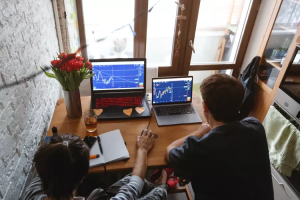 A Comprehensive Guide to Building Technical Analysis Skills
A Comprehensive Guide to Building Technical Analysis Skills
To learn technical analysis effectively, one requires a strategic combination of quality education, practical experience, and the latest technology. In a rapidly evolving trading environment, to gain proficiency, start by building a solid foundation using reputable courses and learning platforms while also gaining hands-on experience through paper trading and demo accounts. Additionally, embracing the latest technological advancements, such as AI-powered analysis and modern charting tools, can further enhance skills.
Key Takeaways
- Start by reading foundational books and taking reputable courses to build a solid theoretical understanding of technical analysis.
- Set realistic goals, maintain emotional discipline, and continually refine strategies through learning and practical experience.
- Verify credibility of educators by checking for industry-recognized certifications, positive reviews, and transparency in course content.
- Practice trading using demo accounts to apply technical skills in a simulated, risk-free environment.
- Learn about risk management, including stop-losses and position sizing, as it is key to sustainable trading success. Also backtest strategies while avoiding overfitting to ensure the approach works well in both historical and live markets.
Understanding Core Technical Analysis Concepts
Technical analysis is rooted in the study of past price actions, psychological influences, and statistical measures. At its core, chart patterns like head and shoulders, double tops, triangles and wedges serve as visual representations that help traders identify potential trend reversals or continuations.
Indicators such as moving averages, Relative Strength Index (RSI) and Bollinger Bands provide a quantitative lens through which market conditions are assessed. Also, understanding support and resistance levels gives an edge in determining key price zones where buyers or sells may dominate.Furthermore, concepts from behavioral economics such as herding behavior as well as sentiment driven indicators add a psychological layer to technical analysis, helping traders and investors comprehend the emotional forces behind market and asset movements.
Equally important is risk management, which ensures that losses remain within limits, preserving trading capital over the long term. Techniques such as position sizing, stop-loss orders, and maintaining a risk reward ratio are fundamental in protecting downside while maximizing potential gains.
Educational Resources
Embarking on a journey to learn technical analysis requires the right mix of educational resources, structured courses, and hands-on practice. Numerous books, online courses, and free platforms can help build a solid foundation. Below are some of the most valuable tools and resources that will help develop a comprehensive understanding of market behavior and effective trading strategies.
Technical Analysis Books
One invaluable step in understanding and mastering technical is reading foundational books. These books offer structured concepts ranging from the basics of chart patterns and indicators to advanced insights into market sentiment and crowd psychology. These contain tested strategies and historical context, helping to learn techniques that have been validated over decades.Two of the most respected books in the discipline are Robert D. Edwards and John Magee’s Technical Analysis of Stock Trends and John Murphy’s Technical Analysis of the Financial Markets. Both offer a comprehensive guide to technical analysis.Additionally, Japanese Candlestick Charting Techniques by Steve Nison, explores the powerful candlestick patterns while The Definitive Guide to Point and Figure: A Comprehensive Guide to the Theory and Practical Use of the Point and Figure Charting Method by Jeremy du Plessis takes a deep dive into point and figure charting.These works are arguably the classics for a reason, they provide the tools and knowledge to help navigate the complexities of the market, consistently apply strategies, and refine skills over time.
Online and Offline Courses
It is important to prioritize quality and credibility in exploring technical analysis courses. There are a variety of options, from beginner friendly platforms like Udemy and Coursera to the highly specialized Chartered Market Technician (CMT) and Certified Financial Technician (CFTe) programs.Reputable educators will emphasize the foundational aspects of technical analysis, risk management, and practical market applications. Moreover, they will avoid making unrealistic claims about guaranteed profits. Opting for courses that are accredited by recognized institutions and regulators or offer structured certifications like the CMT.
Educational Websites
An alternative approach to building a strong foundation in technical analysis without incurring high costs is through free online resources that provide good educational content. Many platforms offer detailed overviews of technical analysis concepts, chart patterns, and indicators, making them superb starting points. Some of the top online resources include:
Investopedia
Investopedia arguably has one of the most popular educational resources for financial knowledge. It provides comprehensive articles on technical analysis, trading strategies, chart patterns, and indicators. With easy to understand explanations and examples, Investopedia is really good for traders at all levels.
Tradingview
Tradingview has a public library of scripts and ideas shared by traders globally. This platform is not just for charting but has a community where traders share insights and strategies. Users can create and publish studies using pine script, which provides a hands-on approach to understanding how different indicators are built and utilized.
Charts School
The website StockCharts.com has a Charts School that provides detailed explanations of various technical indicators and charting techniques. Their library of articles covers indicators, oscillators, chart patterns, and general trading strategies.
Fidelity Learning Center
Fidelity provides free educational content through its Learning Center, which includes articles and webinars focused on technical analysis. The website offers a combination of videos, guides, and articles on various technical analysis topics, ranging from chart patterns to momentum indicators. Many of the webinars are led by professional traders and analysts, allowing participants to gain insight into the practical use of technical analysis strategies.
CME Group
The CME Group provides a range of courses and materials that focus on technical analysis, particularly in futures and derivatives trading. The CME courses cover more specialized areas, like understanding market depth and volume profiles.
Developing Trading Systems
Building a trading system involves developing a set of rules that align with the trader’s or investor’s risk tolerance, market preferences, and investment objectives. This process involves defining objectives, choosing a suitable strategy, setting entry and exit rules, incorporating sound risk management, backtesting, and forward testing, and creating a tailored system that centers discipline and consistency.
Another possible approach would be to rely on off-the-shelf commercial systems. However, this comes with significant downsides, including lack of transparency, unrealistic claims, poor adaptability, and costly subscriptions with no guarantee of success. These pre-made solutions can often rob traders of valuable opportunities and tend to overfit historical data, making them unreliable in the real world.
When it comes to developing a trading system, one should take the time to invest in self-development so that technical analysis and the strategy chosen can be understood thoroughly, allowing for sustainable, long-term success in the financial markets.
Backtesting
One of the more important areas of trading systems design is backtesting. This allows traders and investors to simulate how the trading rules would have performed using historical data without risking real capital.To backtest effectively, the data should be high quality. Also, the entry, exit and risk management rules should be clearly defined. Additionally, reliable backtesting software should be used.Through statistical analysis, including profitability and drawdowns, the trader will gain insight into the strengths and weaknesses of their strategy. Cautious system optimization is needed while using walk-forward analysis to ensure adaptability to new data rather than overfitting to the past.
Avoiding overfitting data is key to creating a robust strategy that works in real trading conditions. Overfitting happens when a strategy is overly tailored to historical data. This leads to impressive backtest results that often fail in live trading because the model cannot adapt to new market conditions.
Keep the trading strategy simple with minimal parameters to avoid overfitting data. To test the strategy, cross-validation and utilizing out-of-sample data should be used. Focusing on creating a relatively straightforward and adaptable strategy can increase the chances of success, which is necessary in the dynamic and unpredictable world of live trading.
Paper Trading
Another powerful way for traders to practice and refine their strategies in a risk-free environment is to use demo accounts, also called paper trading accounts, provided by brokers and platforms. This approach allows traders to execute trades, test different technical analysis setups, and adjust strategies without the financial pressure of having real money at stake.This kind of simulated trading helps build discipline, improve execution skills, and gain familiarity with market dynamics. Also, demo accounts provide a realistic market simulation with access to real-time data and trading tools, which makes them an effective training ground that traders can use before moving to live markets or even testing new strategy ideas.Nonetheless, paper trading has its limitations. There is a lack of emotional pressure which is often needed to become great traders and investors. Also, the differences in execution compared to real trading environments, like slippage or liquidity issues, should not be ignored.
To mitigate the issues with paper trading, trading with small amounts of real capital can help bridge this gap and provide invaluable experience in managing emotions. It can help make the shift from paper trading to live trading smoother and more effective in developing a long-term, sustainable trading approach.
Utilizing Technology and Platforms
It is amazing how technology has fundamentally changed how traders learn and practice technical analysis, making it more accessible and effective, and even proving the efficacy of chart patterns and indicators.Online platforms offer advanced charting tools, customization features, and even paper trading accounts, allowing traders to practice strategies risk-free. Online resources, brokerage education centers, and interactive webinars provide accessible learning opportunities for all levels of experience.Moreover, social platforms facilitate community engagement, where traders can learn from peers and experts. There are apps for those interested in automation, which make it possible to build an execute rules-based strategies with consistency, eliminating emotional biases.
Indeed, automated trading tools and demo accounts have simplified the journey from theory to live trading. By leveraging technology, traders and investors can efficiently and effectively build, test and apply robust trading systems, accelerating their learning curve and enhancing their confidence before really committing to the markets.
How can one assess the credibility of online courses and educators?
When evaluating online courses on trading and technical analysis, one should focus on credibility by checking the instructor’s credentials, course transparency, and independent reviews. Look for educators with relevant experience or certifications like CMT, CFTe or MSTA, and avoid those making unrealistic claims about guaranteed profits. Quality courses should have a detailed syllabus, emphasize risk management, and provide real-world examples.
Can Technical Analysis be Applied to All Types of Financial Markets?
Technical analysis is extremely versatile and can be applied across various financial markets, including stocks, forex, commodities, bonds, and cryptocurrencies. While the core principles such as analyzing price charts, indicators, and patterns are consistent, each market has unique characteristics that require slight adaptations.
What are the Latest Technological Advancements in Technical Analysis Tools?
Recent advancements in technology have greatly improved technical analysis tools, making them more sophisticated and efficient for traders. The integration of AI and machine learning has enabled predictive modeling to identify complex patterns, while advanced charting platforms now offer enhanced customization, real-time visualization, and pattern recoginition.
The Bottom Line
Overall, the best way to learn technical analysis in this modern era is to leverage both traditional educational resources and modern technological tools. A comprehensive learning approach includes understanding foundational concepts through credible courses, utilizing interactive platforms for hands-on practice, and staying informed of the latest technological advancements, such as AI-enhanced analysis and mobile charting tools. An edge could be developed by combining theoretical knowledge, consistent practice via demo accounts, and the latest technological advancements.
Trade around the clock
Sponsored
Did you know that 82% of Bitcoin’s gains between March 2022 and February 2023 happened outside of regular Nasdaq hours?* HotCoin offers on 600+ digital asset trading 24 hours a day, meaning you never need to miss out when the markets move. Join now for super-fast execution backed by dedicated support. 74-89% of retail CFD accounts lose money *Data from the Hotcoin Global platform.
Advertiser Disclosure
